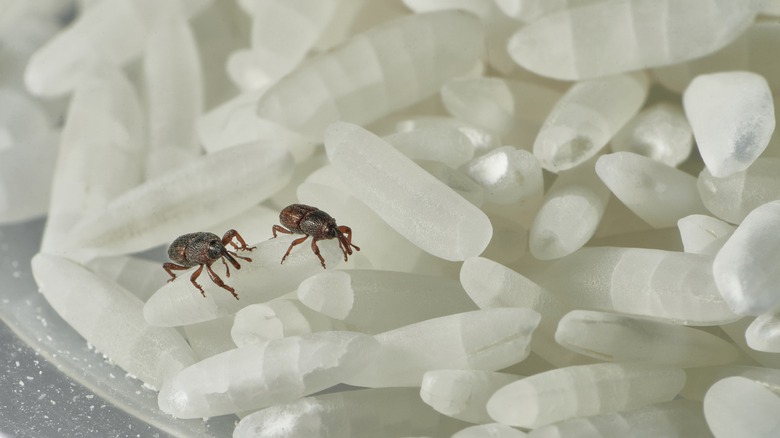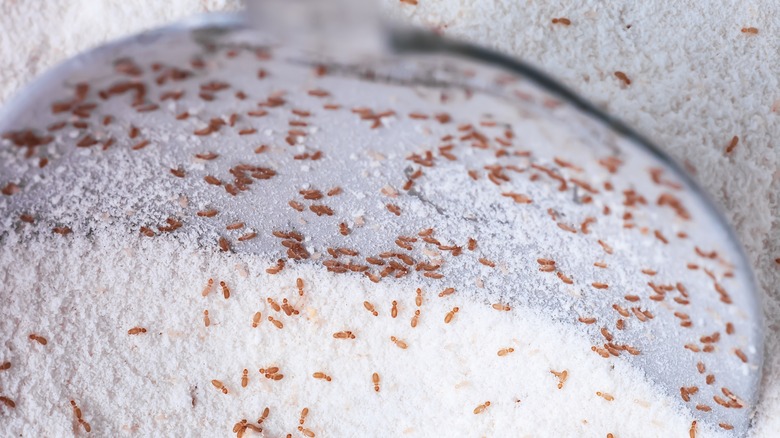FIFO Method: What It Is & How To Use It To Keep Pests Out Of Your Home
If the kitchen is the heart of the home, then a well-stocked pantry is its lifeblood — quietly pumping out delicious and nutritious ingredients. The secret to managing your food storage area is having a reliable plan for organization. To ensure that your dry goods are not inviting unwanted pests, you may want to try the FIFO or "First In First Out" method. Whether you store your food staples in a pantry, cupboard, garage, or basement, these tips will help you have a pest-free experience throughout your home. Simply put, the FIFO method ensures that your oldest pantry staples are the ones you use first. This not only guarantees product freshness but also reduces the chances that bugs may come to dine on your dime, as you won't forget items in the back of your pantry where they could get swarmed by bugs. Of course, you certainly don't want to entertain the thought of bugs or their eggs and larvae in your baked goods.
Certainly, the kitchen can be host to many undesirable insects, some of them so small you might not notice them at first — little menaces like rice weevils and flour beetles. The biggest culprits for attracting these bugs are the staples most often stored in bulk for convenience: flour, rice, cereals, pet food, seeds, and other dry ingredients. But by using best practices to organize your pantry and understanding the First In First Out process, your food storage spaces can stay neat, fresh, and pest-free.
Tiny bugs can be a big nuisance
The biggest kitchen offenders are actually very small and have highly descriptive names like Indian meal moth, granary weevil, confused flour beetle, and drugstore beetle, just to name a few pantry pests to be on the look out for. Sometimes they hitch a ride in the products before you've even bought them. It is possible for eggs laid in the field before harvest to make it through the milling process and end up in your bag of flour or rice where they hatch. It's also likely that the bugs entered your home afterward, which is where the FIFO method can come in handy. Just like any bugs, they're looking for an easy food source and will gravitate toward small spaces where food is spilled and forgotten. If you are always using your oldest items first, they likely won't find a messy pantry with opened items.
If you suspect you have bugs but don't know exactly what to look for, consult the NC State Extension, which shows you the bugs' appearance and which type of stored food they're attracted to. Any badly compromised food should be thrown out immediately, but if you catch it early enough, you can heat or freeze the items to try and salvage them. For the heating method, put the product on a baking sheet in a 130-degree Fahrenheit oven for 30 minutes. To freeze bugs and larvae, place them in a freezer for at least four days.
Using the FIFO method for food storage
The first step in avoiding the pests altogether is to keep a neat storage space. Keeping your pantry or cupboards clean and free of spilled products is crucial. If bugs can't get a foothold and find a continuous food source, they will not take up residence in the first place. One of many pantry storage hacks that will keep your kitchen organized and tidy is to move your dry goods into glass jars with lids. Not only will the jars keep your pantry staples dry and airtight, but you can also easily see what's inside them. You can purchase all new matching jars for a consistent look or simply begin saving containers you would otherwise recycle. As you fill the jars, be sure to label them with the product's original sell-by date.
Then, as you buy new products for your pantry, place the newest items in the back behind the already-opened containers, so those get used first and don't attract insects. You've probably noticed that grocery stores also use this system to manage their inventory. Storing your food items this way also extends to canned goods and other non-perishables — not because they will attract bugs, but so you use them before their expiration dates. The FIFO method can also be used for toiletry items such as shampoos and soaps that degrade over time. When using the FIFO method correctly, you'll reap the benefits of fresh and bug-free storage spaces.


